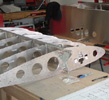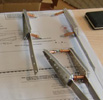


random user submitted photo
Airball progress
4 posts
• Page 1 of 1
Airball progress
I thought I'd post here about my "homebuilt aviation" project. A couple days ago was a milestone in getting full data from the sensor to the display. It's sort of the home stretch now to get to a flying prototype of the full system:
https://www.youtube.com/watch?v=D9BiSEkD2Rs
Ihab
https://www.youtube.com/watch?v=D9BiSEkD2Rs
Ihab
Ihab Awad, San Jose, CA
- ihab
- Posts: 159
- Joined: Sat Mar 09, 2013 1:45 pm
- Location: San Jose, CA (KRHV)
Re: Airball progress
Ihab
Excellent. I would love to test fly it in my Sonex!
Excellent. I would love to test fly it in my Sonex!
Robbie Culver
Sonex 1517
Aero Estates (T25)
First flight 10/10/2015
375+ hours
Jabiru 3300 Gen 4
Prince P Tip
Taildragger
N1517S
Sonex 1517
Aero Estates (T25)
First flight 10/10/2015
375+ hours
Jabiru 3300 Gen 4
Prince P Tip
Taildragger
N1517S
-

Sonex1517 - Posts: 1670
- Joined: Fri Jun 03, 2011 10:11 am
- Location: T25 Aero Estates, Frankston, TX
Re: Airball progress
Will this be useful?
A continuous AOA readout could be very nice, but would need to have a large scale, like full height of screen I think to be really useful. Same with yaw, the scale would need to be pretty wide so that small changes were clearly perceptible.
The size of the ball for airspeed part I am not so sure I see as useful, maybe more distracting plus it seems like that would take away from the perception of precision on the two axis.
Gordon
A continuous AOA readout could be very nice, but would need to have a large scale, like full height of screen I think to be really useful. Same with yaw, the scale would need to be pretty wide so that small changes were clearly perceptible.
The size of the ball for airspeed part I am not so sure I see as useful, maybe more distracting plus it seems like that would take away from the perception of precision on the two axis.
Gordon
Waiex 158 New York. N88YX registered.
3.0 Liter Corvair built, run, and installed.
Garmin panel, Shorai LiFePo batteries.
3.0 Liter Corvair built, run, and installed.
Garmin panel, Shorai LiFePo batteries.
- GordonTurner
- Posts: 668
- Joined: Tue Feb 21, 2012 1:14 am
- Location: NY, NY
Re: Airball progress
GordonTurner wrote:A continuous AOA readout could be very nice, but would need to have a large scale, like full height of screen I think to be really useful. Same with yaw, the scale would need to be pretty wide so that small changes were clearly perceptible.
The size of the ball for airspeed part I am not so sure I see as useful, maybe more distracting plus it seems like that would take away from the perception of precision on the two axis.
These are all really good questions and until more people, including CFIs, are flying this thing, I can't tell for sure. :)
The reference point is the center of the ball, and I think you can get an idea of how big the ball is even though part of it may be scrolled off the screen. So as currently designed, the center of the ball can span the entire width and height of the screen. So I think the current display does satisfy your need for precision, which I do agree with by the way.
As for the size of the ball, the idea is that (a) it is useful if you are in accelerated conditions; (b) speed is still something you worry about so it's good to know it; (c) it's helpful to let you know when you're going too fast so you don't hit Vne; and (d) it's pretty much a freebie from the instrument so why not? But if it's distracting, then maybe it should be removed. I don't know yet.
One thing I have *not* done yet but which I hope to do is provide a TAS "ring" around the speed ball. It's trivial for the probe to measure barometric pressure and temperature. With that, you can compute TAS. And so my plan is that, if TAS differs from IAS by more than a certain percentage (say 5% or whatever), then a TAS "ring" appears around the ball showing the "spread" between TAS and IAS. This should hopefully be helpful in judging density altitude -- it won't help you with your takeoffs, but it might help with landings, and might also help you quickly "see" what's wrong should you ever end up in a high DA situation. This is sort of what it might look like:
https://docs.google.com/presentation/d/1ab41f37PfOW9tzPD-fXZ4HzVswL2MzD9nmD3jcEVV3M/edit#slide=id.g1822ed93bf_0_243
So basically, my idea here is to try and think of all the attributes of the air flow vector, and display them in the most useful way possible. Any attribute that's useful should stay. Any that's merely distracting should go. :)
Ihab
Ihab Awad, San Jose, CA
- ihab
- Posts: 159
- Joined: Sat Mar 09, 2013 1:45 pm
- Location: San Jose, CA (KRHV)
4 posts
• Page 1 of 1
Who is online
Users browsing this forum: No registered users and 22 guests







